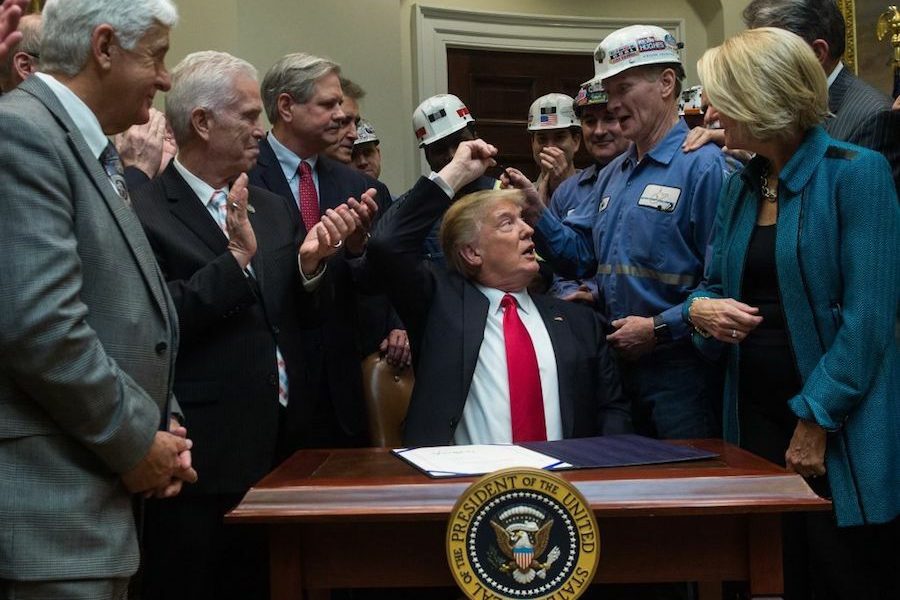The Media Uses Coal Miners To Attack the Green New Deal—Then Ignores Their Pension Fight
Sarah Lazare

Anna Attie, Eleanor Colbert and Daniel Fernandez contributed research to this report.
To stave off the worst effects of the climate crisis, at least 80 percent of coal reserves must stay in the ground, according to a conservative estimate in the journal Nature. This means that coal miners would see their already declining industry all but disappear. The Green New Deal, the resolution put forward by Rep. Alexandria Ocasio-Cortez (D-N.Y.) and Sen. Ed Markey (D-Mass.) for an economy-wide mobilization to address the climate crisis, calls for a “just transition” that guarantees good new jobs for coal miners. Some insist that the “just transition” start now, which is why they are supporting the American Miners Act.
Introduced in the Senate on January 3, the Act protects the pensions of more than 100,000 coal miners whose retirement fund was depleted by the 2008 crash. It also rescues the healthcare benefits of miners whose companies went bankrupt last year.
But you wouldn’t know about this bill, or its sister legislation in the House, from reading the New York Times, the Washington Post or Politico, three influential outlets within the Beltway. None have reported on — or mentioned — the legislation since it was introduced in early January, even though it has the support of the United Mine Workers of America (UMWA) and high-profile cosponsors like Sen. Bernie Sanders (I-Vt.), Sen. Elizabeth Warren (D-Mass.) and Ocasio-Cortez.
Yet these outlets have given considerable space to coal miners and unions to advance other narratives. In a four-month period this spring and summer (February 25 to June 25), the New York Times, Washington Post and Politico have published 34 articles and opinion pieces that touch on coal miners or their unions. Collectively, they paint coal miners primarily as a source of votes, and assume that the sole political motivation of that bloc is opposing environmental policies that would close mines.
Seven stories discuss the decline of the coal industry or the new mergers, without mentioning the American Miners Act. Seven describe Democrats’ attempts to reach out to coal miners. One mentions rising suicide rates among coal miners in the Midwest. One includes brief mention of a coal miners’ strike more than a century ago. Only one piece highlights coal miners’ present-day concerns about workplace conditions: an article about silica dust causing a resurgence of black lung, that was produced by Reuters and reprinted by the New York Times. And only one discusses how the Green New Deal could support coal miners.
By far the most frequent reference, in 16 stories, was to depict coal workers as a conservative constituency. These 16 stories either pit coal miners’ livelihoods against robust climate action, reference miners’ support for regressive policies like environmental deregulation, or discuss miners who back President Trump. When coal miners speak against progressive policies, particularly environmental ones, they’re more likely to be given a platform. When they issue demands that affect their everyday survival, they’re on their own.
Politico and the Washington Post gave considerable space to the opposition of coal miners and unions to the Green New Deal, with three articles in this period highlighting the topic. By contrast, only one article, a 855-word opinion piece in the Washington Post, made the case for why coal miners should support the Green New Deal.
Overlooked blue-green alliances
These Green New Deal articles are worth examining, because they establish a narrative that there is an insurmountable divide between elite climate activists and workers just trying to get by. On March 12, the Washington Post ran the headline, “AFL-CIO criticizes Green New Deal, calling it ‘not achievable or realistic.’” The piece centered on a letter of opposition to the Green New Deal co-drafted by Cecil Roberts, the president of the United Mine Workers of America, and Lonnie Stephenson, president of the International Brotherhood of Electrical Workers, on behalf of the AFL-CIO’s energy committee.
Yet, on May 8, when Roberts rallied at Capitol Hill to call attention to the existential threat posed to retired coal miners’ livelihoods, the Washington Post was mum. Alongside the Alliance of Retired Americans, the Association of Flight Attendants (AFA) and multiple members of Congress, Roberts made an impassioned case for the American Miners Act, the aforementioned legislation that would transfer money to the UMWA pension fund, a boon to workers whose benefits were threatened by the Great Recession. “We didn’t get any of the money you sent to Wall Street. You bailed them out,” Roberts shouted from a podium. “What about the people who work for a living in America? What about the people who’ve given their health to America?”
The press conference would have also offered an opportunity to report on alliance-building between coal miners and Green New Deal proponents. And in fact, Sara Nelson, president of AFA and vocal supporter of the Green New Deal, spoke at the press conference. “Flight attendants are here, with our miners, to make sure that miners’ healthcare and pensions are preserved,” she said. “They earned them.”
In a May interview with In These Times, Nelson emphasized the importance of rallying behind the bill. “We need to push to adopt legislation that keeps America’s promise to coal miners of pensions and healthcare,” she said, “as well as addresses black lung— that’s the bare minimum to show good faith that this process of taking on climate change will focus on making coal miners’ lives better, not worse.”
As labor and climate activists grapple with difficult questions about how to transition away from a fossil fuel economy without leaving workers behind, major media outlets remain stuck in a reductive “elite vs. blue-collar” divide. In These Times contributor Michelle Chen noted that this false dichotomy appears throughout a June 1 Politico article, “Labor anger over Green New Deal greets 2020 contenders in California.” The article quotes Jack Pitney, described as “a veteran California political analyst and political science professor at Claremont McKenna College.”
He says there’s a “cautionary tale” for Democrats, who should remember that “West Virginia, until 2000, was considered solidly blue.” Republican strategist Karl Rove, working for candidate George W. Bush, pushed the fact “that the Democratic nominee was Al Gore, author of ‘Earth in the Balance,’’’ a fact that didn’t sit well with coal miners, Pitney recalls.
The piece cites unnamed coal miners as a warning to Democrats: If you campaign on the Green New Deal, you will lose elections. But reality is not so simple. While it is true that labor leaders in the building trades and extractive industries have expressed criticism or outright opposition to the Green New Deal, they don’t represent all of labor, nor all of their own rank-and-file membership. As Stanley Sturgill, a retired coal miner, told me at the People’s Climate March in 2014, “I worked underground for 41 years and I have black lung disease. I’m actually having a hard time breathing just to get to this stage. I am marching today because I want to build a bright future for my family, for Appalachia, and for this world. I have a vision where my children, grandchildren, great-grandchildren can have good jobs that support our families without doing damage to our water, air, land and climate.”
And in fact, a survey by the progressive think tank Data for Progress in June found that “union membership is one of the factors most highly correlated with support for Green New Deal policies, as well as the Green New Deal framework as a whole.”
Some unions, locals and labor federations have come out in support of the Green New Deal, including the Service Employees International Union, the San Diego and Imperial Counties Labor Council, the Maine AFL-CIO and the Los Angeles County Federation of Labor. And labor and climate groups worked together to pass landmark climate legislation through the New York legislature in June, thanks in part to the backing of the New York State Amalgamated Transit Union, Teamsters Joint Council 16 and the Communications Workers of America Local 1108. Environmental and workers’ groups have long tried to build cross-movement trust and solidarity, years before the Green New Deal was introduced.
The Black Mesa Water Coalition, for example, has long organized in Arizona to build support within coal mining communities for a just transition from coal. And Kentuckians for the Commonwealth organizes coal mining communities, including coal miners with black lung, to push for a transition away from fossil fuel extraction, rooted in opposition to climate change and the devastating health effects of coal mining. The organization has been talking about the need for a just transition for at least a decade, meaning that coal mining communities deserve partial credit for advancing this concept. In the former coal camps of Lynch and Benham, the organization is working to help residents envision and fight for a just transition to renewable energy, from protesting mountaintop removal to retrofitting homes.
The climate stakes
But perhaps the most glaring omission in Politico’s June 1 article is its failure to reckon with the stakes. Whether to support or not support a Green New Deal is not a question of political strategy to win voters or union support, devoid of context. The UN’s IPCC report, released in October, estimated that we have 12 years to keep global warming under 1.5 degrees Celsius and save hundreds of millions of people from devastating environmental destruction, poverty and death. This is a crisis that hurts poor and working-class people most, particularly those in the Global South, who are already seeing their societies uprooted by intensifying storms, draughts, and sea-level rise. Miners, who are on the front lines of hazardous fossil-fuel extraction, are not spared.
To be sure, a May 7 article in the Washington Post does emphasize the urgency of the climate crisis before noting the concern that it would “put coal miners out of work.” And it is worth noting the one Washington Post op-ed, published April 19, that defends the Green New Deal against critics like Rep. Garland “Andy” Barr (R-Ky.), who dared Ocasio-Cortez to come his district.
“The Green New Deal specifically addresses the need to help people in communities affected by the transition away from fossil fuels,” the article notes. “It calls for “directing investments [to] deindustrialized communities, that may otherwise struggle with the transition away from greenhouse gas intensive industries.”
Yet the 855-word opinion piece may do little to counterbalance the narrative of conservative, anti-environmental coal miners reinforced across many stories. This lopsided focus contributes to the impression that the gulf between coal miners and climate justice campaigners is impossible to bridge.
“Mine workers are not the enemy here, and I think the press does play them out to be,” says Joe Uehlein, the president of the Labor Network for Sustainability, a coalition of labor and environmental groups. “But they’re not. They’re potential allies if we can wrap our heads around real full-spectrum ‘just transition’ policies and fight for them.”
Accomplishing this transformation will require nuance and respect for the lives of coal miners who are hurting from dried-up pension funds, something influential media outlets could use more of.
Sarah Lazare is the editor of Workday Magazine and a contributing editor for In These Times. She tweets at @sarahlazare.








